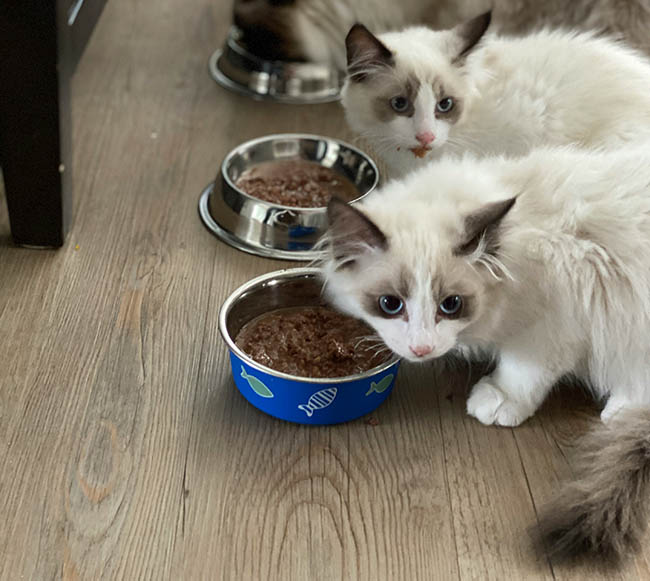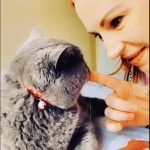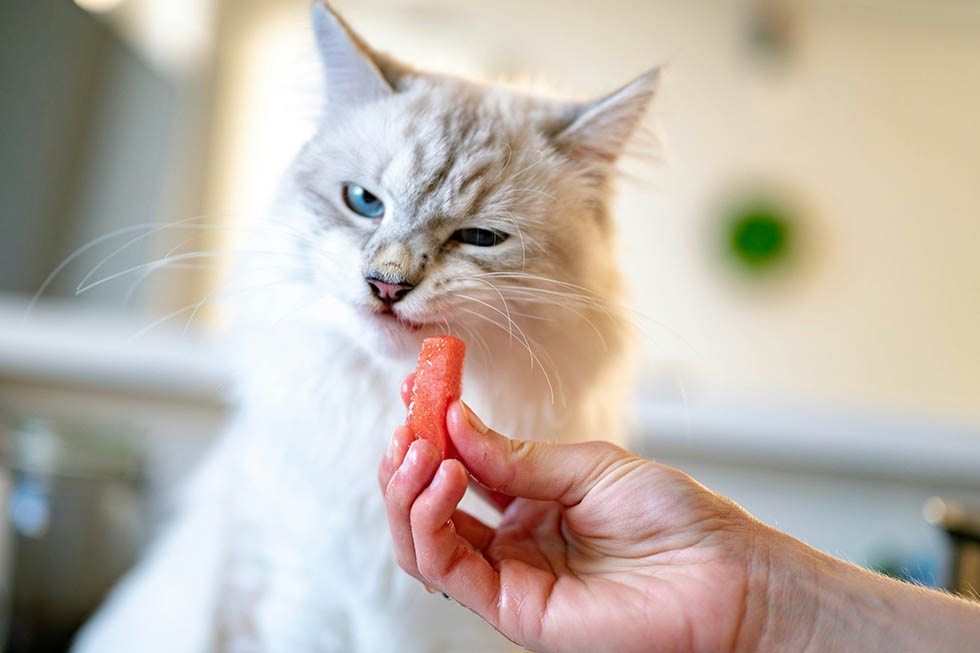Can you relate?
I have often found myself standing, bewildered in the cat food aisle, perplexed as to what my seemingly fickle and fussy cat might deign to eat this week…
This frustration is shared with around half of the pet parents I work with. Research shows that over 40% of cats are ‘fussy’ or ‘picky’ when it comes to their food.
And it can get worse. It may be a day-to-day struggle where ‘Food A’ is delicious today, then a haughty though adorable little nose is turned up at this now ‘unacceptable’ food the very next day. Buying cat food in bulk is just not an option for many of us. Much of it spoils or ends up donated when our furry masters stage a hunger strike…oftentimes randomly.
But why are cats so notoriously fussy? They’re not just ‘being cats’ or trying to annoy us.
It comes down to science!
There are several reasons, and most are rooted in the fascinating evolution of the domestic cat, whilst others are behavioural or due to medical conditions. Much of their fussiness has been genetically programmed to ensure survival. But cats are also unusual, in that if they don’t eat for more than a couple of days, they can develop a life-threatening liver condition, called hepatic lipidosis.
So, there are potentially high health stakes for fussy cats.
The most common reasons for picky eating are as follows:
1. Taste
Cats have a distinct preference for a particular taste. They lack the ability to taste sweetness, meaning we just don’t see the chocolate and sweet tasting antifreeze toxicities we do in dogs… and instead they have specialised taste receptors on their tongues for amino acids, found in animal proteins. Cats prefer foods that are high in protein and have moderate levels of fat, and they love the ‘umami’ flavour, or the so-called “essence of deliciousness.” This is a Japanese term referring to a rich, meaty taste, characteristic of cooked meats and broths.
Why is this?
During their evolution, cats developed a unique metabolism where, unlike most other species, they primarily use protein and fat for energy. Cats are obligate carnivores, meaning they must eat meat to survive.
Carbohydrates, which may taste sweet (and thus tasteless to a cat) can ‘technically’ be digested by cats, though they did not evolve many of the enzymes required for digestion. As such, carbohydrates are not needed in a cat’s diet. Evolutionarily, our domestic moggies are very similar to their ancestor, the African wildcat, and research shows the natural diet of the domestic cat is entirely small prey animals.
Cats did not evolve with humans, unlike dogs. Cats lived alongside early human settlements, keeping rats and mice under control, protecting crops and grain stores. Dogs joined human tribes and were domesticated, trained, bred for tameness, and the domestic dog has evolved to eat what people eat. Including carbohydrates.
2. Smell
A cat’s sense of smell is crucial in deciding whether a food is tasty, and most importantly, safe. Cats will reject food that doesn’t smell appealing, and we have long underestimated the power of their noses!
When a cat has cat ‘flu and a blocked nose and cannot smell their food many of their humans notice their cat will stop eating. As cats age, their small receptors atrophy or degenerate, and their ability to use this sense to determine what is appealing and safe to eat declines. Older cats and those with a blocked nose often prefer stronger smelling food, and warmed food, which has a stronger aroma.
This is not so pleasant for us humans….but is quite enticing for our cats. This is also why a lot of cats like fish-based foods, although fish is not what they evolved to eat and is not ideal for them in large quantities.
Importantly, cats like fresh food. Wildcats, their close cousins, instinctively know to avoid decomposed or contaminated prey, as these are likely to cause illness. Our cats are just the same.
3. Texture
Cat food texture is important to cats. Some cats may prefer wet food over dry food or vice versa, and even within those categories, they may have specific preferences (pâté, shredded, chunky, etc.). Sick and older cats and the professional fussy cat will often eat just the gravy. This is the yummiest part. But why? This is where the meat and protein – that they’ve evolved to seek out – is found. Often the meaty ‘chunks’ in commercial cat food are made of carbohydrates of plants such as soy, and these are not as naturally appealing to cats.
4. Temperature
The temperature of our cats’ food can be critical. Cats have evolved to eat rats, mice, small rabbits, birds and sometimes lizards and insects. They prefer their food at “small mammal body temperature” as it mimics the temperature of their natural prey, freshly caught. This is another example of how the evolution of the cat as a specialist hunter drives their habits and preferences.

5. Variety
Some cats, like mine (Mao), become dedicated to the same food every day and will refuse to try anything new. This known as neophobia, or ‘fear of anything new.’ But many others desire variety, being the ‘spice of life’ and are easily bored with the same meals, becoming fussy. These adventurous types have ‘neophilia,’ and enjoy new dining experiences.
6. Diet Changes
As cat parents, we know first-hand that cats do not enjoy sudden changes in lifestyle. This applies to their food too! Sudden changes in diet can lead to fussiness, meaning they generally need time to adjust to new types and textures of food, or new flavours. Abrupt changes to diet often lead to tummy upsets, creating a negative association with the food.
7. Health Issues
We frequently overlook health problems, many of which show up as fussiness. Dental disease and pain, gastrointestinal issues like food intolerances and stomach ulcers, chronic kidney disease, infections such as cat ‘flu that cause sore throats, mouth ulcers and loss of sense of smell, or other health concerns can make eating uncomfortable, leading to fussiness around food. Cats with arthritis are in severe pain and appetite may be affected. On the other hand, cats with diabetes and hyperthyroidism tend to eat voraciously and are less fussy.
8. Anxiety and stress
Changes in a cat’s environment or routine often leads to stress, affecting eating habits. Stressed cats may eat less or be more selective about what they eat. I recall one patient who staged a hunger strike simply because his parents went on holiday! The location and cleanliness of their feeding area is critical. A quiet, safe, and clean feeding area is preferred, away from the litter box. Many cats do not like to eat near their water bowl.
9. Competition
Competition is not always healthy! In multi-animal households, competing for food may lead cats to become anxious about eating, especially if they feel they must hurry or compete for their meals. Cats usually have dominance hierarchies, and this determines who gets to eat what and when. Many pet parents also struggle with having cats with differing dietary needs or appetites. An overweight ‘chonker’ cat may be guarding food and preventing another cat from accessing it, or individual cats may have different and incompatible eating patterns. Some might like to eat twice a day, whilst others prefer to graze.
10. Nutritional composition
Cats have very specific nutritional requirements and if they do have a deficiency, they may seek out certain types of food, or begin to eat non-food items; a medical condition known as ‘pica.’ Cats with inflammatory bowel disease (IBD) and problems with absorbing their food are often deficient in B vitamins. Cats also naturally prefer high animal-derived protein and fat containing foods. Studies offering cats meals with higher or lower protein content show cats naturally select the higher protein versions. This is due to those specialised taste receptors and reduced ability to digest carbohydrates.
Of note, corn and soy contain protein may contribute to the overall protein content of a food, though these lack critical amino acids that are essential to a cat’s health. They are also less digestible, or accessible when compared to animal protein.
Diets that are higher in carbohydrates, which are often dry kibble, and include grains or non-grain carbohydrates such as corn, potatoes, soy, legumes, rice, tapioca, and vegetables, cause a cat’s pancreas to release insulin to regulate the spike in blood glucose. Cats are uniquely sensitive to these spikes, given they evolved to use animal protein and fat as sources of energy, rather than carbohydrates. This insulin release makes a cat hungrier, and this can make some cats eat more of the high carbohydrate foods, leading to obesity and diseases such as diabetes and arthritis.
Carbohydrate content in cat food is not legally required on the package label, so it can be difficult to decipher what is in a food.
Dr Andrew, at the Walkerville Vet Clinic, has created an online calculator that allows easy understanding of the amount of carbs in your cat’s food. Many vets recommend that carbohydrates make up no more than 10-15% of a cat’s diet, and others, me included, consider less than 5% as ideal as this replicates what our cats evolved to eat.
11. Weather!!
Have you noticed your fur baby eats less during summertime? Many cats self-regulate their appetites to match calorie intake with summertime reductions in exercise and a reduced need to use energy to maintain body temperature. Research shows that most cats, even indoor cats, eat around 15% less in the warmer months.
12. Breed
Some breeds of cats are pickier with their food than others. Some eat like the proverbial horse…Burmese cats – I’m looking at (most) of you. British shorthairs often enjoy the finer things in life … demanding far more calories than they require. In contrast, breeds such as the Siamese, Persians and Oriental are notoriously discerning in what they will eat.
I have noticed though, that many cats from rescue, or shelters, are far less fussy. We can assume this is because their lives before adoption have been hard, without a secure food source or knowing where their next meal will come from. This is tragic though makes caring for them easier!
13. Type of bowl
Cats may have a preference for how their food is presented. Some cats prefer ceramic bowls, or glass ones. Mao loves her stainless-steel food bowl and adores some pottery ones I sometimes pull out of the human cupboard…shhhhh! Plastic bowls can be harder to clean and therefore harbour nasty bacteria and fungi, affecting food taste and smell. Plastic is a common cause of skin irritation in cats too!
Some cats prefer elevated bowls, and many like their food served up high, where they feel safe and can survey their world. And whilst the existence, or not, of ‘whisker stress’ is hotly debated, some cats do like flat bowls, and less pressure on their sensitive whiskers whilst they eat. Finding the ‘just right’ food bowl can be a matter of trial and error.
There may be other causes for feline fussiness, and please contact me at bec@drbecvet.com if I’ve left any out! However, there is some method to the apparent madness or fussiness of our feline companions. In the next article I will detail ways to encourage fussy cats to eat. Some small tweaks can be all that is needed, though it is always wise to check in with your vet to make sure there is nothing more serious underlying picky eating.
Finally, I have a vested interest in helping my fussy patients and cats of Australia! To solve the problem, I have developed, and hand-make, a 100% wild rabbit food topper, Dr Bec’s Hopper Topper, that works for the fussiest of the fussy cats … and I am sending free samples to fussy pet parents all over Australia … one needs to try before they buy any food with these cats!
If you’re interested in trying a free sample, or finding out more about cat health, please visit me at www.hopper-toppers.com
Post Views: 136

Dr Bec is a Melbourne-based veterinarian and academic, working in the clinic, animal welfare, the media and research. Dr Bec is a regular guest on Melbourne radio, and writes for Australian Dog Lovers’ Magazine, Australian Cat Lovers’ Magazine, and Pet Insurance Australia. Her passion is sharing of evidence-based veterinary medicine, and the empowerment of pet parents, through the understanding of our pets’ health, and our own. Bec’s research focuses on the microbiome in animal health, preventative medicine, developing new veterinary medicines, and working to prevent antibiotic resistance.


